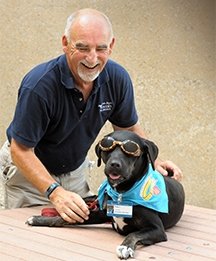It didn’t take Art Lauderback long to recognize the therapeutic potential of Betty, a 45-pound black Labrador mix that he adopted two years ago.
Not long after adopting Betty, the Charleston man started taking her to visit his mother who had fallen and was being cared for, first, in an assisted living facility and, then, in a nursing home. “Betty’s just very gentle and she’s good around people in wheelchairs and in beds,” he said, explaining that the residents loved Betty. The visits continued nearly every day for more than a year.
Art learned the importance of Betty’s visits when he arrived without her one day. “I found out quickly that Betty was much more important than I was,” he said. “She entertained all of the people in the nursing home. They looked forward to seeing her every day.”
Art decided after his mother died in July 2017 that he would have Betty certified for pet therapy. Since SBL was finalizing plans to implement a pet therapy program, Art and Betty became the Health Center’s pilot dog/handler team when the program launched in May 2018.
Pet therapy has been proven to reduce stress, anxiety, pain and fatigue in patients with a variety of health conditions, and “it certainly brings a smile to people’s faces,” Colleen Stoner, director of Volunteer Services, said. She coordinates SBL’s Pet Therapy Program. “The program is off to a great start for patients, and it has opened up a new avenue for volunteering at the hospital.” In fact, Colleen quickly learned that she needs additional volunteers to accompany a growing number of dog/handler teams on their visits.
SBL pet therapy dogs are certified by the Alliance of Therapy Dogs or Therapy Dogs International. This means that they have completed temperament testing and the highest level of obedience training. Handlers complete SBL volunteer orientation and safety screening, and they commit to volunteering for an hour weekly. Volunteers accompany dog/handler teams to the rooms of patients who request visits. Patients simply talk to, stroke or cuddle therapy dogs for a few minutes while they visit.
The program is designed to keep interactions between dogs and SBL patients safe. In fact, infection control staff members were instrumental in developing policies and procedures to ensure the safety of patients. Only those patients deemed well enough to interact safely with therapy dogs are allowed to visit with them.
“I love bringing Betty out here. It gives me a chance to give back and it’s very rewarding,” Art said. “There are always a few patients who are just overjoyed to see her. You can see it in their faces, and their families thank me for bringing her.”
He continued, “Betty’s figured things out. I put the therapy collar on her and tell her we’re going to work, and she knows what she has to do.”
Art’s passion for the program also stems from his son’s experience 20 years ago with pet therapy dogs. “My son had cancer when he was 10 years old, and he went through 14 weeks of chemotherapy at St. Louis Children’s Hospital. They had therapy dogs in the oncology waiting room,” Art recalled. “My son didn’t look forward to the chemo, but he looked forward to seeing the dogs. It helped him relax once he got in there.”
Colleen concurred. “People are just so joyful when the dogs are on the floor, and I love that the dogs are helping people take their minds off their problems and anxieties for a while,” she said.
For more information about the pet therapy program or to become a volunteer, contact SBL Volunteer Services at 217 258-2500.

